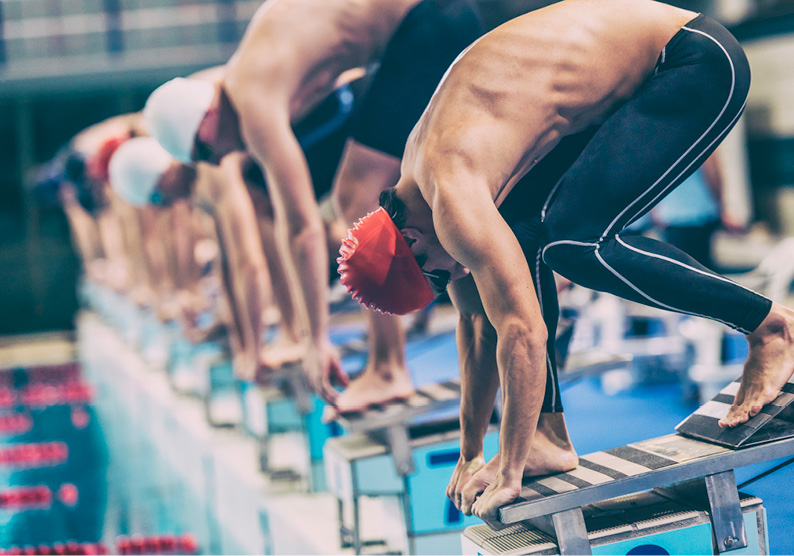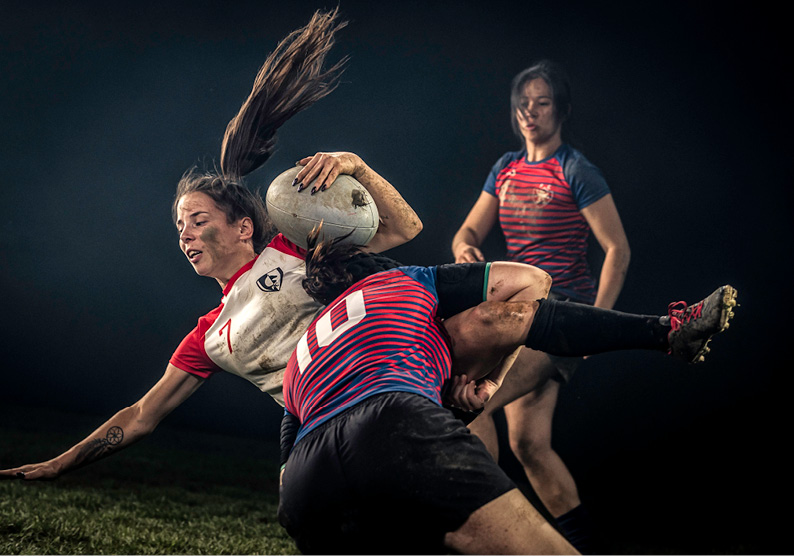“There’s a saying that there’s more law in the back pages of a newspaper than the front”
Injury, integrity, technology and TV deals are just some of the areas for a new generation of sports lawyers.
Kendall Harris has always considered herself to be a sports nut. But it wasn’t until she worked on the privatisation of ACT Government-owned sports betting agency ACTTAB in 2012, that she realised she could combine her passion and profession. Harris started studying the few sports-related subjects offered at Masters level but found the local sports law industry dispiritingly difficult to crack.
Fortunately, she says, that’s changing.
After a stint as Director of Legal and Governance for World Sailing in the UK, Harris now heads up the Australian arm of Onside Law. She’s seeing a transformation of the sports law arena, from undergraduate courses through to an increase in both in-house sports law roles and firms offering sport as a focus area. “Sports organisations are now finding that they need someone that understands the nuances of sport. You can be a commercial lawyer and have done 1,000 contracts but if you’re looking at a sport contract, there are differences that you need to be able to pick up, from regulatory overlays to stakeholder engagement issues.”
There’s also the odd perk for the genuine sports lover. “We’ve recently been working with the Australian Grand Prix Corporation,” says Harris. “And when I tell people things like that, they say, ‘Oh, your job must be amazing’. Nine days out of ten, I sit at my desk and draft contracts, like every other lawyer.
“But the day I ended up on the grid at the Grand Prix, with the smell of fuel swirling around and the deafening noise of the engines, that was a real career highlight. So sometimes, being a sports lawyer is as cool as it sounds.”
Is sports law even a thing?
What is sports law? Is there a lex sportiva? Or is it more “sports and the law”? Is there a unique corpus of substantive ‘sports law’? These are questions David Thorpe has been considering for almost two decades. Thorpe teaches sports law at the University of Sydney. In 2005, he devised and ran one of the first undergraduate sports law classes in Australia. Four years later, in 2009 he co-wrote the first comprehensive text covering sports law.
“It was a huge task because it covers around 15 distinct areas of law, from governance and torts to doping and competition law,” he tells LSJ.
The fourth edition of Sports Law in Australia has just been published and the number of universities teaching sports has increased significantly. While it is difficult to quantify the number of lawyers working on sport-related matters, according to the Australia and New Zealand Sports Law Association (ANZSLA), membership has increased by 54 percent over the past 20 years.
“There’s a saying that there’s more law in the back pages of a newspaper than the front,” he says.
“Whether or not that’s true, legal issues involving sport are now at the cutting edge of many sports developments, from restraint of trade to issues of discrimination and off-field behaviour. And because sport’s now a multi-billion-dollar industry around the world, significant money can hinge on legal outcomes.”
 David Thorpe, sports lawyer
David Thorpe, sports lawyer
Harris says as an external law firm, this increasing sophistication has created two main areas of growth: overflow work where in-house lawyers need support with their business-as-usual work; and niche project work where sporting organisations are having to grapple with complex and novel demands.
“It might be a big ICT procurement, a new broadcast deal, or an NFT deal,” says Harris. “These sorts of issues require specialised skills, or sometimes an in-house counsel simply wants some backup.”
The burgeoning breadth and evolution of sports law isn’t just driven by money. Tony O’Reilly, Board Director of ANZSLA, says one of the reasons that sports law is interesting is that it’s a fractious area by nature.
“Clubs are competing with one another, players are constantly in contests, so legal issues come up more frequently than they do in other commercial areas of a similar size,” he says.
O’Reilly, a partner with Kardos Scanlan and a sports lawyer of more than 20 years, also believes that sport tends to be in the vanguard of where legal issues arise. “Discrimination or transgender issues have arisen in sport early because sport provokes real-world examples easily that are in the public domain,” says O’Reilly.
“It intersects with some of the broader societal issues and because it’s an ongoing, dynamic environment, issues can percolate in to the law through the lens of sport.”
It’s not just societal issues seeping first into sports law. The emergence of technology, such as Web3 and non-fungible tokens (NFTs), has mobilised a host of major sports and law firms.
At the recent NFT Fest 2022 conference in Melbourne sporting organisations such as Tennis Australia, Cricket Australia, the AFL, NRL and the Australian Grand Prix indicated that they were looking at how they could integrate blockchain-based collectibles into their businesses. The same conference also featured representatives from firms Herbert Smith Freehills, King & Wood Mallesons, Piper Alderman, Stirling & Rose and Hall & Wilcox.
“As sports break down all the assets they own and look at how they best commercialise them, we’re seeing a lot of sports looking at new technology. For example, highlight-based NFTs have changed the way sports share and fans engage with highlights,” Harris says.
She says some people now see the main value of a sports property being the five minutes of highlights, whereas others still see it being the full match. “How a highlights-based deal works with traditional broadcast deals, and carving up exclusivity categories, is going to be an evolving issue. And if you don’t get the definition of what you’re selling exactly right, that’s when you end up in disputes.”
While NFTs might seem at the bleeding edge of sports law, Harris argues the issues are often commercial law with a sports overlay. “NFTs really go back to who owns the IP behind them,” she says, “who owns the copyright, do they have the ability to license it, and so on.” But there are also interesting regulatory issues being raised. For example, she says, “if NFTs and other tokens are being marketed to fans as something that can be bought, sold or traded for value, does it need to be regulated? Or are they just the new, digital version of trading cards?”

Integrating integrity
One area that has remained a constant in sports law is the issue of integrity. Questions of general discipline on and especially off-field behaviour of the participants in a sport fill the back and sometimes front pages of newspapers. Sports betting on outcomes of and within games looms ever larger, as betting agencies expand and amounts wagered increase.
Then there’s performance enhancing drugs and doping that has threaded through modern professional sports for decades. The Tour de France has suffered countless major doping scandals, from the early days of cocaine and ether-soaked sugar to the spectacular downfall of seven-time winner Lance Armstrong.
The Olympics has been beset since the late 1960s, with Canadian sprinter, Ben Johnson, one of the first high-profile athletes to fail a drug test in 1988 (five of his fellow runners in the 100-metre final failed a test or were sanctioned for doping).
In Australia, the Essendon supplements saga dragged on for five years. Players for the AFL club were found to have been injected with banned supplements, resulting in the club being handed a $2 million fine, 34 players suspended for two years, the person responsible for the program receiving a lifetime AFL ban and the senior coach and general manager suspended for 12 months.
The case also exemplified the various in-house, national and international bodies governing sport, having variously involved the AFL Integrity Unit and Tribunal, WorkSafe Victoria, the Australian Crime Commission, the Australian Sports Anti-Doping Authority (ASADA), World Anti-Doping Authority (WADA) and the International Court of Arbitration for Sport, whose decision to sanction the players in the Essendon case was ultimately upheld by the Federal Supreme Court of Switzerland.
“Tribunals are extremely important in maintaining the stability and integrity of a sport,” Thorpe says. “They’re challenged in law from time to time but they’re very sophisticated now. There’s very little that players can object to because they get a proper hearing.”

Sport Integrity Australia was set up in 2020 in response to the Federal Government’s Review of Australia’s Sports Integrity Arrangements, known as the Wood Review. The body was created as a central agency taking on the functions of ASADA, the National Integrity of Sport Unit and the nationally focused integrity functions of Sport Australia.
The National Sport Tribunal (NST) was set up at the same time to “hear and resolve national-level sporting disputes in Australia”. The pilot program offering arbitration, mediation, conciliation and case appraisal to national level sporting bodies and their participants has recently been granted four more years of Federal Government funding to 2026-27.
While sports like the AFL, Cricket Australia and the NRL can maintain tribunals with a comprehensive and substantive remit and resourcing, smaller sports often don’t have the financial resources or the manpower to conduct these reviews so it makes sense for them to use an independent body such as the NST.
ANZSLA also offers educative and professional development opportunities, and over the years has offered pro bono services to help the smooth running of integrity and governance across all sports, large and small. O’Reilly, who has been an ANZSLA member for over 20 years, says the creation of Sport Integrity Australia and the NST are important but he expects the bigger sporting bodies will continue to operate their own integrity units and disciplinary processes given the protective nature of the jurisdiction being exercised.
Mind matters
Among the many areas of law that impact sports today, one issue looms larger than most for both participants and sporting bodies: concussion and chronic traumatic encephalopathy, commonly known by its abbreviation, CTE. According to the Australian Sports Brain Bank, CTE is a “brain condition that is caused by repeated exposure to mild traumatic brain injuries. These may or may not be associated with concussion [and] it is important to know that not everyone who experiences repeated mild traumatic brain injuries will develop CTE. We do not currently understand why this is the case.”
In 2013, 4500 former American Football (NFL) players who sued the league over head injuries sustained won a US$765 million payout. Central to the class action were examinations of former players that showed evidence of CTE, however the settlement did not establish there was a link between head trauma and CTE. As questions of causality remain, the Australian Sports Brain Bank has found the first cases in CTE in ex-players of Australian Rules football, rugby league and rugby union. While no class actions have yet been launched in Australia, a former AFL player with the Richmond Football Club, Ty Zantuck, received approval from the Victorian Supreme Court to sue his former club for concussions suffered in the early 2000s. Zantuck was diagnosed with suspected CTE in 2021 (CTE can currently only be definitively diagnosed in a post-mortem). Richmond has not yet appealed the Supreme Court ruling nor has Zantuck filed for damages.
 Emma Johnsen, Senior Associate at Marque Lawyers
Emma Johnsen, Senior Associate at Marque Lawyers
“Some studies have shown a link between depression and repeated head trauma … I think clubs need to understand that their duty to look after players should continue”
So where does that leave any potential claim against Australian sports that involve a risk of concussion? The answer is far from straightforward. In the words of Thorpe: “It’s difficult law and difficult proof. And that goes back to the nature of the disease itself, and how it’s caused and when sporting organisations knew or should have known of the risk of CTE and, indeed, a player’s response if warmed of that risk.”
In a recent report by Legalign Global, a global alliance of insurance-related law firms, titled A Knockout Blow: The current state of CTE and concussion litigation in Australia and around the world and co-authored by Sydney-based partner, Charles Simon of Wotton + Kearney, potential legal issues will fall into four major categories: establishing causation; the ‘state of knowledge’; compliance with concussion policies and procedures; and statutory defences.
Thorpe says that apart from establishing a causal link, sports lawyers will need to understand the steps clubs and sporting organisations took to understand the risks of CTE and what they did in the face of those risks.
“The American forensic pathologist, Dr Bennet Omalu, published his paper on CTE after examining the brain of the NFL player, Mike Webster, in 2005,” he explains.
“Then in 2009, a metastudy was published that listed a range of other contact sports where CTE was a potential problem – rugby, lacrosse, soccer, hockey, horse riding, wrestling and obviously boxing. Since 2005 and especially 2009, sports can’t argue that there wasn’t plenty of information available if they wanted to look. In fact, from the 1970s on, medical sources reported on CTE-like harm in sports other than boxing.”
On the other side of the equation is the notion of voluntary assumption of risk by the athletes or players. This hinges on whether the player is properly informed, that participants are fully aware of what the risks involve, and that they voluntarily assume and acknowledge the risks along with the possibility of harm.
While it is incumbent on the clubs and governing bodies to ensure that every player is fully informed about the risk, the problem for clubs and sporting bodies, says Emma Johnsen, Senior Associate at Marque Lawyers, is ensuring the clubs are comfortable the information about the risks is properly delivered. “Are clubs enforcing attendance at information sessions? Are they being properly informed? Are they actually listening in at the sessions?”
One argument which may arise is from club doctors and coaches who downplay the risk. This could be the case when clubs and their staff merely pay lip service to any information about future effects of a concussion injury. A player in this case could argue they were informed of the risk, but it was subsequently downplayed or scoffed at by the coaching or medical staff.
“This is similar to the Essendon supplements case where players were told not to worry about the injections of potentially damaging substances,” says Thorpe. “And this is an interesting thing about athletes. People think they’re dominant and imperious but at the club, they’re actually very compliant.”

While concussion protocols that ensure a mandatory absence from a sport and, in many major sports, allow for independent assessments of head trauma, some believe that less than adequate policing of the protocols themselves could be the genesis of future claims. Once a protocol is brought in, clubs and organisations are obliged to ensure that it’s enforced.
“In the case of the NRL and the AFL, as the overseeing body who has power to punish clubs, if they don’t act upon the concerns of concussions and CTE, they’re likely to be liable,” Thorpe says.
“So much hinges on what the organisation has promised or impliedly promised to do by introducing these concussion protocols. The other question is the causative weight to be given to one failure to enforce a protocol as against the multiple symptomatic and asymptomatic concussions associated with the contraction of CTE.”
These implied promises were on stark view in the recent FIFA World Cup game between Iran and England. Despite FIFA’s protocols, albeit voluntary, that include a concussion saliva test and the use of virtual reality technology as well as ‘concussion spotters’, the Iranian goalkeeper, who was clearly concussed after a collision, remained on the field for another 10 minutes before being substituted.
Luke Griggs, interim chief executive of brain injury charity Headway UK, said at the time that “this was the first test of the FIFA World Cup concussion protocol and it was an abject failure.”
While we’re waiting to see what arguments are made and how the courts proceed, Thorpe offers a cautionary observation for future litigants. “People who take on a concussion case probably think it looks pretty straightforward,” he says, “But as they get into it, they will no doubt realise there’s not an area of the argument where there’s an easy ride.”
There are other complications for sports lawyers to also consider. Over the past decade, Australia has witnessed the rise of professional women’s sport, with competitions such as the AFLW, NRLW, Super Netball, WBBL and Super W all now receiving increased visibility and viewerships, and the athletes finally being paid a comparable (but not equal) wage.
The Matildas, meanwhile, have become one of the most well-known national teams, and in 2019 were ranked ‘Australia’s most beloved team‘.
Johnsen says with current concussion research dominated by impacts in men’s professional sport, more consideration needs to be given to women’s sport. “Women’s bodies are different, the impacts are different and the way women fall is different,” she says. “As more women play contact sports at both an amateur and professional level, we need to ensure that the concussion research and specific protocols keep pace.”
Johnsen also believes there have to be stronger safety-nets for elite and professional athletes after they finish their sporting careers. The recent suicide of former NRL player and coach, Paul Green, is a tragic example.
“Some studies have shown a link between depression and repeated head trauma,” says Johnsen, “I think clubs need to understand that their duty to look after players should continue and that, even though someone has finished their contractual obligations, thought needs to go into longer-term support. That might not be a formal legal duty of care once the contract has ended, but at least ethically, there needs to be focus on this area whether that be by a club or a governing body.”

The way we watch
The way sport is broadcast and consumed is evolving at mind-bending speed. From viewing on mobiles and tablets to subscription streaming and ‘over-the-top’ broadcast services, sports are now sliced and diced for the consumer in ever more niche ways.
Recently, the government has closed the consultation period into the anti-siphoning scheme set out in the Broadcasting Services Act 1992, that considers “coverage of nationally important and culturally significant events, such as the Olympic and Paralympic Games, AFL, Rugby League, Tennis, Cricket and Melbourne Cup.” The anti-siphoning scheme was introduced in 1994 in a landscape almost unimaginably simple when compared with today.
As the ground continues to shift, the sporting industry and rights management issues are coming to the fore. “Sports and broadcasters really do have to be ahead of the curve in how viewers are going to be consuming media in the future,” says Johnsen, “because these broadcast deals are often for five years or more years. So, for example, if you signed a rights deal in 2018, the way that people are consuming sport is already pretty different since then. Today, sports need to be thinking about how things will be consumed in 2028?”
Johnsen says the commercial and legal teams will need to consider exploitation of intellectual property, piracy, exclusivity and non-competes. “It’s not strictly a legal issue, but I also think that commercial teams will need to plan for a time when people just won’t want to pay for a dozen different streaming services to access different sports,” she says.
“COVID-19 has also made force majeure clauses so much more important with whole seasons being cancelled or games being played without spectators, affecting the atmosphere and quality of the game.”
Then there’s the control and implications of player contracts colliding with ever more atomised rights. Under traditional collective bargaining agreements, players would pool their image rights with the national governing bodies owning them in most contexts, says Johnsen. Personal endorsements were fine, as long as there was no conflict with anything connected to the club or sporting body. “The idea has been that the revenue share model compensates them for the fact that they’re not able to commercialise the images themselves,” says Johnsen. “But when you’re adding NFT deals into it, for example, some of the NFT deals that we’re seeing coming out of the Premier League are astronomical. I think it’s going to be really interesting seeing how that works because our highly-centralised leagues in Australia operate with such a different model to the rest of the world.”
Whatever the issues and however sports law is defined, however, one thing is clear: this area of law is only going to expand. “Everyone is talking about the green and gold runway of major events coming to Australia in the next 10 years,” says Harris. “Whether it’s the FIFA Women’s World Cup or the Olympics in Brisbane, these major events mean major growth in the industry. If nothing else, it really is a pretty exciting time to be working in sport in Australia.




